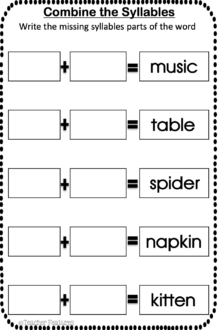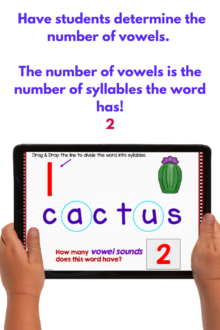Strong readers need to be proficient at decoding multi-syllable words and a powerful way to learn this is by teaching syllable types and syllable division. Once students are able to do this, it is much easier to read and understand more difficult and longer words. But, how do students know if the vowels in a word are long or short vowels? The sound of the vowel is determined by syllable types. This can be done by looking at the word and finding where the natural breaks are. For example, the word “table” can be divided into “ta-ble.”
Below, we look at the six different types of multi-syllable words, as well as how syllable division can help improve your reading skills. Let’s get started!

Syllable types and syllable division are key to decoding multi-syllable words
Closed syllable words (ex. “cat”): These words have one syllable that is closed off by a consonant. The vowel in these words is usually short.
Open syllable words (ex. “go”): These words have one syllable that is open, meaning there is no consonant at the end of the word. The vowel in these words is usually long.
Vowel-consonant-e syllable words (ex. “cake”): These words have one syllable that ends with the letter “e.” The vowel in these words is usually long.
R-controlled syllable words (ex. “car”): These words have one syllable that has the letter “r” following the vowel. The vowel in these words is usually short.
Consonant-le syllable words (ex. “table”): These words have one syllable that ends with the letters “le.” The vowel in these words is usually silent.
Vowel Team syllable words (ex. south): A vowel team syllable is a syllable with two vowels working together to make one sound. Diphthongs are often included in this syllable type.
Something to keep in mind when dividing multi-syllable words:
A syllable can never have more than one vowel. This means that if there is more than one vowel next to each other, they will be divided into separate syllables.

Multi-syllable word fluency improves reading skills
We all know students who have no difficulty with reading. But, what about the struggling students? Using syllable division helps striving readers decode multi-syllabic words by breaking words down into smaller pieces. Words that were daunting become readable. The less time and effort a reader needs to spend figuring out a word, the better reading comprehension will be. When you spend time to teach students basic syllable types and syllable division, your students will be decoding like a pro in no time.



